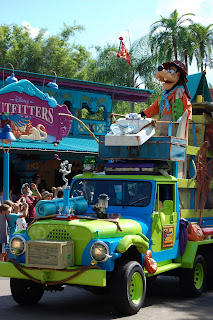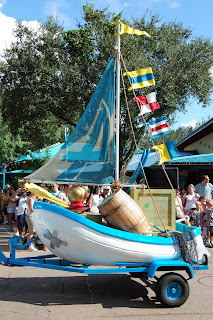One of my favorite aspects of Mickey's Jammin' Jungle Parade at Disney's Animal Kingdom is the Adventure Rovers for each of the VIP characters in the show. These customized Jeeps are not only personalized for each character, but are also packed to the gills with everything they "need" for a camping expedition.
Minnie's Rover, complete with bow and polka dots, is hauling a pair of picnic baskets, along with all the comforts a lady like Minnie would never leave home without. Look for hatboxes and trunks (adorned with stickers from Minnie's travels through Disney's Animal Kingdom), a vanity table and phonograph... even a bathtub with rubber (Donald) duckie, leaving a trail of bubbles as she goes.
Goofy's up next, and he's brought everything... including the kitchen sink! There's a fishing pole, lantern, snowshoes (just in case), golf clubs, tennis racket, tent, radio, pots, pans, broom, washboard, tea kettle, long johns, windsock, barbecue grill and more. The hood ornament on Goofy's Rover is an old bowling trophy, which occasionally tips back as the engine overheats and needs to blow off steam. Look closely at the hood of the Jeep... you'll see the Goof really is prepared for anything! That's the Flying Carpet and lamp from Aladdin. You never know what kind of wish you may need granting when you're lost in the jungle!
A beak leads Donald Duck's Adventure Rover, fully equipped for aquatic fun on this jungle expedition. He's got SCUBA gear, a raft, nets, paddles, inner tubes, an old-fashioned dive helmet, water skis and even a crow's nest (complete with crow). Donald's sailboat has seen better days, but he's patched it up and is ready to go!
Mickey Mouse brings up the rear of the parade with the largest Adventure Rover of them all. Leave it to the Big Cheese, though, to be the most sensible and frugal of packers. He's loaded up with just the things he truly needs - clothes, sleeping bag, supplies and some satellite radio equipment to keep in touch with his pals - allowing plenty of room for extra Guests to ride along.
Mickey's Rover is also completely inclusive. Rather than celebrating himself, it's a tribute to various members of the animal kingdom, from the golden lion hood ornament to the paint scheme in patterns of zebra, tiger, snake, lizard and insect. It's as if all the animals of the entire parade come together for the finale, rejoicing in the "Rhythm of One."

























































